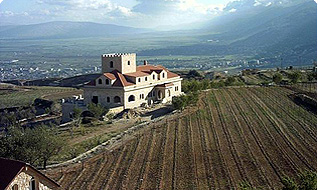
A rich history
Over the ages, Lebanon’s unique geography has earned it a rich and complex wine history. Grape growing and wine production have always had an important place in Lebanese culture.
During the Phoenician era, the Lebanese were masters of the wine trade in the Mediterranean region. Then came the Roman lovers of this drink, who honored the wine god Bacchus by erecting spectacular temples to the deity- - the remains of the most famous can still be seen in Baalbek in the Bekaa Valley today. The history of Christendom too testifies to the reputation of Lebanese wine: it was at a wedding reception in Canaa, south Lebanon, that Jesus turned water into wine.
The inhabitants of Lebanon’s mountains have always regarded wine as a way to store their grape crop for consumption throughout the winter season.
born from passion
The vineyard is a family business born out of Raymond and Brigitte El Khoury’s passion for the vine and wine. The first vines for wine production were planted in 1995 on a land that had been abandoned after the Lebanese civil war. Before the war these vineyard plots had been planted for the manufacture of the famous Arak of Zahle. Old vines and old indigenous grape strains were found in the ground during the early work of trenching and grading. Today the vineyard covers 15 hectares around the Château./p>
The construction of the winery began in 2002 and was completed in time to host the first vinification in 2004. After studying oenology at the Faculty of Reims, Raymond and Brigitte’s son Jean-Paul returned to the château to add the knowledge he acquired during his travels to the best French vineyards to his parents’ wine-making experience.
An exceptional location
Château Khoury enjoys a privileged location in the eastern foothills of Mount Lebanon at an altitude of 1,300 meters. The vineyard’s altitude gives the vines exceptional exposure while maintaining the aridity of the plain in summer.
The chateau overlooks the city of Zahle and offers panoramic views of the Bekaa valley and Mount Hermon. The buildings are built of cut stone, and they respect the purest traditional Lebanese style in order to blend in with this postcard landscape.
